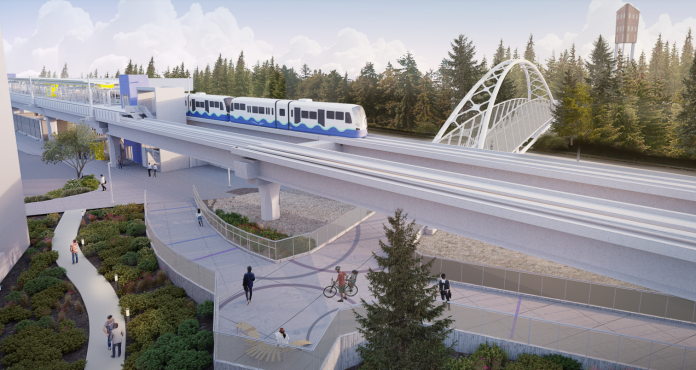
Construction is underway on two projects that Shoreline leaders hopes will play a central role in turning the area surrounding its coming light rail station at NE 148th Street into a denser, more transit-oriented neighborhood. On Monday, Shoreline officials joined county, state, and federal leaders at the station to highlight the new pedestrian and bike bridge connecting the station across I-5 and a full revamp to nearby 145th Street to add more capacity for all modes.
It’s all part of an attempt to amplify the effect of the region’s biggest transit investments by allowing more people to live nearby and easily access them. Shoreline South Station is set to open on August 30, along with three other light rail station that Lynnwood Link extension is delivering to the north.
The $43.6 million pedestrian bridge, which started construction early this year, isn’t set to open until spring of 2026. The year-and-a-half lag time between the station’s opening this summer and the opening of the bridge is due to the fact that Shoreline had been working toward assembling full funding for the project until fairly recently. The City finally received a grant from the U.S. Department of Transportation that took the project to full funding last year.
Once it’s in place, residents in the rapidly densifying neighborhood to the west of I-5, which the City rezoned in 2016, will have direct access to the Sound Transit station without having to head down to the busy overpass at 145th Street.
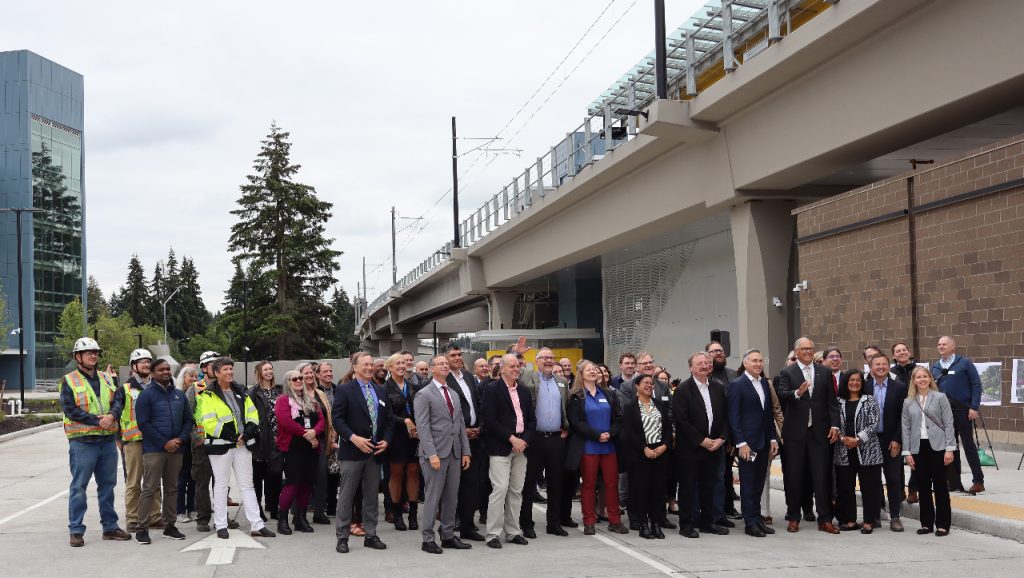
Along 145th Street, construction is also underway on a pair of twin roundabouts on either side of I-5 that Shoreline and the Washington State Department of Transportation (WSDOT) hope will provide safety gains at the same time it adds capacity for vehicles, including buses. Sound Transit’s Stride S3 bus rapid transit line is set to open by 2028 and terminate at Shoreline South/148th Street, providing east-west service along State Route 522 to Kenmore, Bothell, and the I-405 corridor.
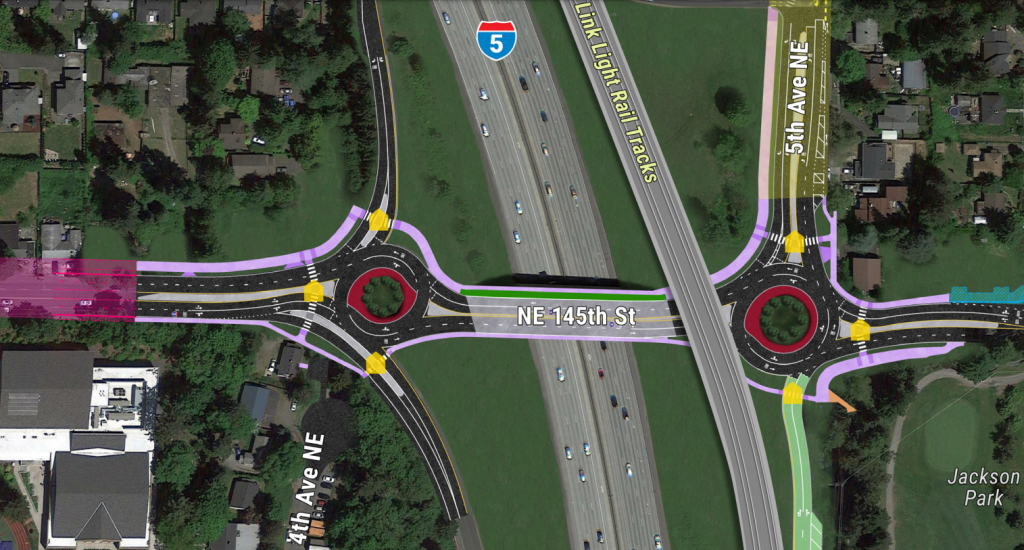
“It was about a decade ago that local staff and WSDOT staff looked at the 145th Street corridor and started to envision what was needed to make sure this corridor [can] meet the region’s growing needs, especially with light rail on the horizon,” Shoreline Mayor Christopher Roberts said. “Shoreline was prepared to make some modifications to this interchange, adding a ramp here, tweaking some lanes there, to improve its ability to connect to the light rail station. But WSDOT insisted that our team keep looking at roundabouts as an interchange solution instead.”
Switching to a roundabout design, Roberts said, is set to improve traffic flow so much that it allowed plans for a new bus-only lane for Stride buses east of I-5 to be dropped, freeing up Sound Transit funding for the interchange project itself.
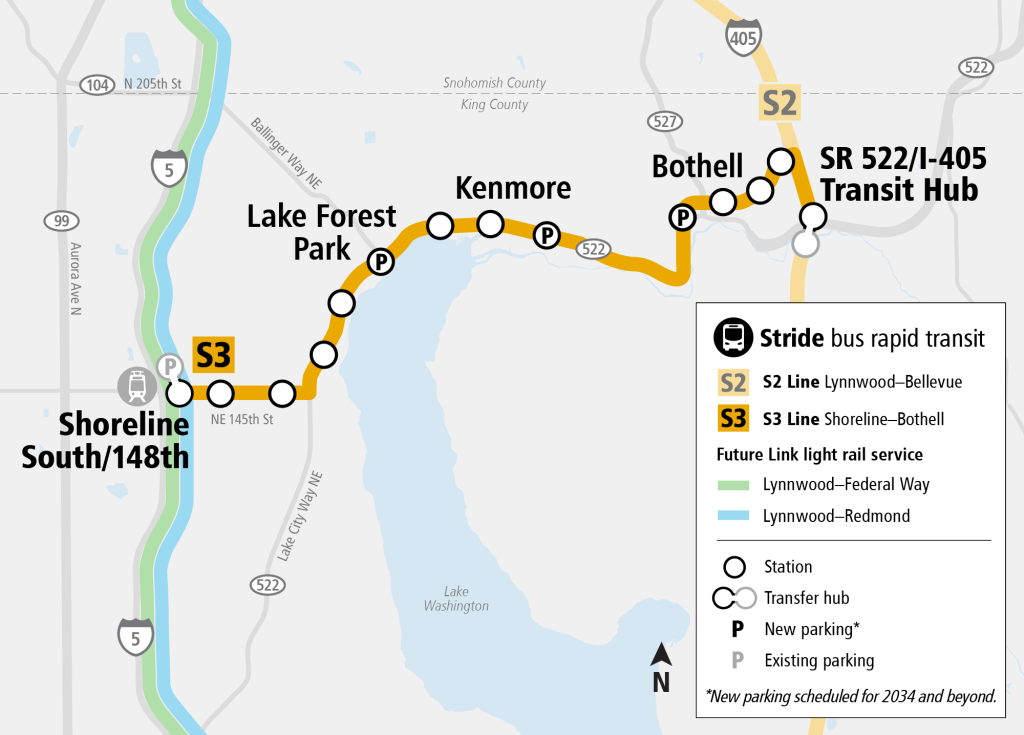
While Shoreline hopes to increase access to what will be one of North King County’s busiest transit hubs, Seattle has taken a different approach on its side of 145th Street. Low-density single family zoning and the sprawling Jackson Park golf course still dominate the land use south of the city limit, with no plans advanced that would change that dynamic any time soon. The contrast with how the two cities are planning around transit investments was on full display at Monday’s event.
“Shoreline has been dedicated to meeting the needs riders and of residents,” King County Executive Dow Constantine said. “Shoreline Station and partnerships that made it a reality are really a model for the whole region. Whether securing funding through our congressional allies or through the state delegation or finding ways to create affordable housing in and around this station area at 148th, Shoreline has earned a well deserved victory lap for leading this work.”
At the same time as roundabout construction, the City of Shoreline is also working to widen 145th Street west of I-5 to add a center turn lane and expand the meager pedestrian facilities along Shoreline’s southern border. Despite acquiring property to expand the roadway, which is a state highway (SR 523), Shoreline did not find any room to include any dedicated space for people on bikes, instead planning to route them via an “off-corridor bike network.”
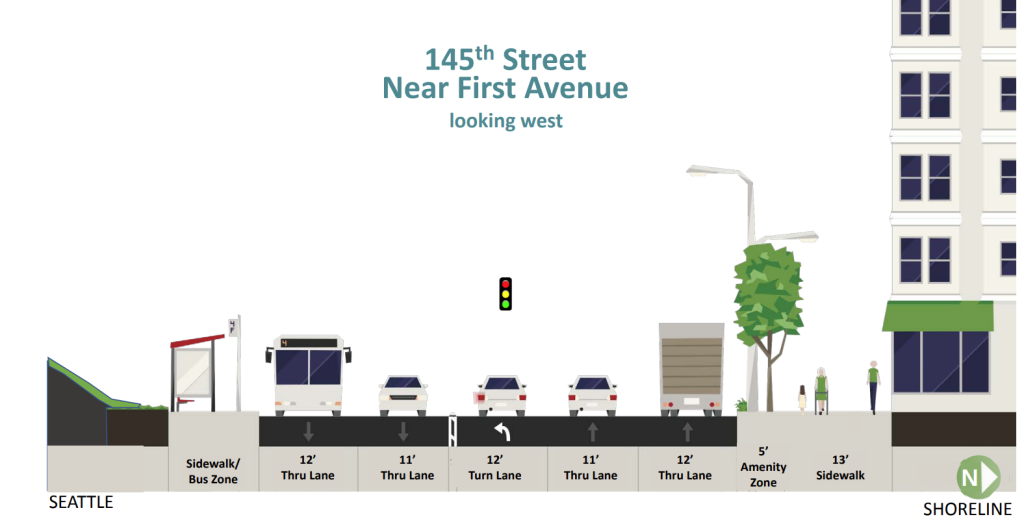
The roundabout project is set to cost $35 million, with another $28 million budgeted for the first phase of the 145th Street corridor revamp, from I-5 to Corliss Avenue N. The entire street all the way to Aurora Avenue N will eventually receive the same treatment. The widening, largely funded via transportation impact fees, is an attempt to reduce traffic congestion, and, given the street’s narrowness, it may be the only viable path for transit lanes, which could ultimately prove essential to serve such a critical hub.
Currently, the western half of 145th Street doesn’t have any bus service whatsoever, but following the start of light rail service, the stretch will be served by King County Metro’s new Route 333, with daytime service every 15 minutes seven days a week. However, buses will be rerouted off the street until later this fall, with the street fully closed to expedite the upgrades. East of I-5, the new Route 72 will offer even more frequent service between the station, Lake City, and the University District.
Few cities in the region of Shoreline’s size are making such a concerted effort to promote homebuilding around its coming light rail stations. After adding just over 1,500 homes between 2006 and 2018 — a fairly standard growth rate for a city of around 60,000 — permits for new units in Shoreline have jumped significantly in recent years, with 1,417 new units permitted in 2023 alone and 1,100 in 2022.
The lion’s share of those homes are being built near the 148th Street and 185th Street light rail stations, but several projects are also going in along Aurora Avenue N, an area that has been booming for years. A second phase of the rezone approved in 2016 is timed to the light rail extension opening and will open up more areas farther from station to development of four-story apartment buildings and the like. The recent wave is largely composed of large midrise apartment buildings. Smaller missing middle projects are lagging further behind, but the City is hoping to make strides in that area in the coming years as well.
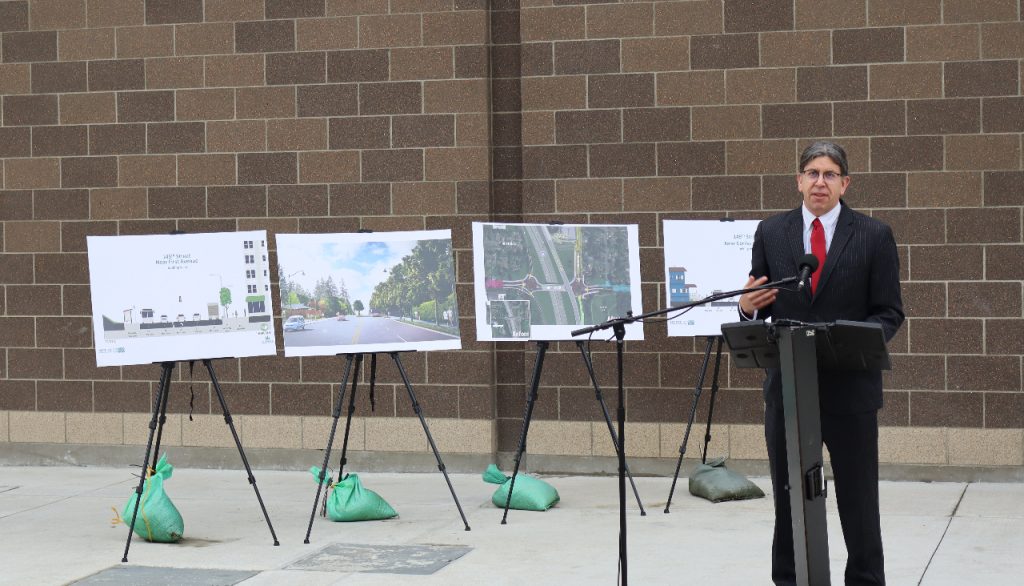
“One of the things I’ve learned as mayor and on the council is that these transportation projects are transportation projects, but they are also housing projects,” Roberts said. “We think about where we are, the fact that we are in a housing crisis, a housing emergency in this region. It’s these infrastructure improvements, these partnerships of our federal, state, and local people coming together, we are providing housing for thousands of Washingtonians.”
Ryan Packer has been writing for The Urbanist since 2015, and currently reports full-time as Contributing Editor. Their beats are transportation, land use, public space, traffic safety, and obscure community meetings. Packer has also reported for other regional outlets including BikePortland, Seattle Met, and PubliCola. They live in the Capitol Hill neighborhood of Seattle.

